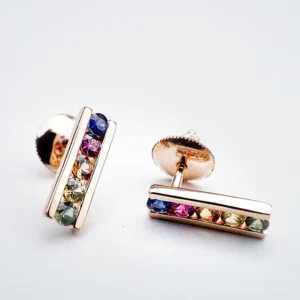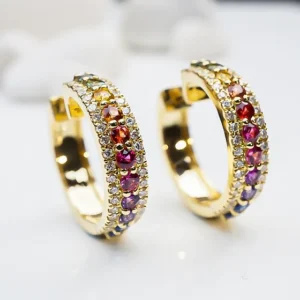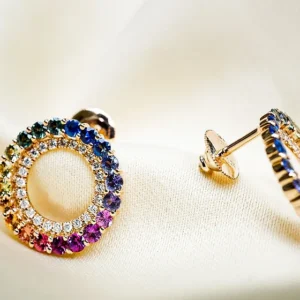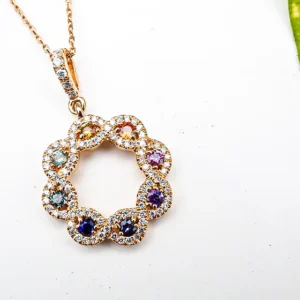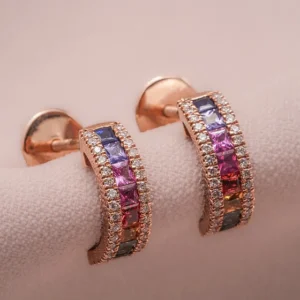Exploring the Allure of Gold Jewelry: A Dazzling Display of Elegance
Gold jewelry, with its captivating gleam and timeless allure, has held a cherished place in human culture and fashion for centuries. Beyond being mere accessories, these meticulously crafted pieces are windows into history, culture, and individual expression.
Table of Contents
Adorning oneself with gold jewelry is not only a way to enhance physical appearance but also a profound statement of personal style, taste, and even societal status.
From delicate gold earrings that frame the face to intricate necklaces that grace the neckline, from elegant gold rings that encircle fingers to ornate gold bracelets that adorn wrists, the world of gold jewelry offers a rich tapestry of options that cater to both men and women.
In this exploration, we embark on a journey that traverses time, design, and sentiment, uncovering the enchanting universe of gold jewelry. We’ll delve into its illustrious history, unveil the allure of its diverse designs, and highlight how these precious pieces serve as tangible forms of self-expression and emotional connection for every individual.
Whether it’s the symbolism of a gold necklace, the finesse of gold bracelets and gold bangles, or the intimacy of a gold pendant, each piece tells a story, and together, they form an exquisite mosaic that resonates through generations.
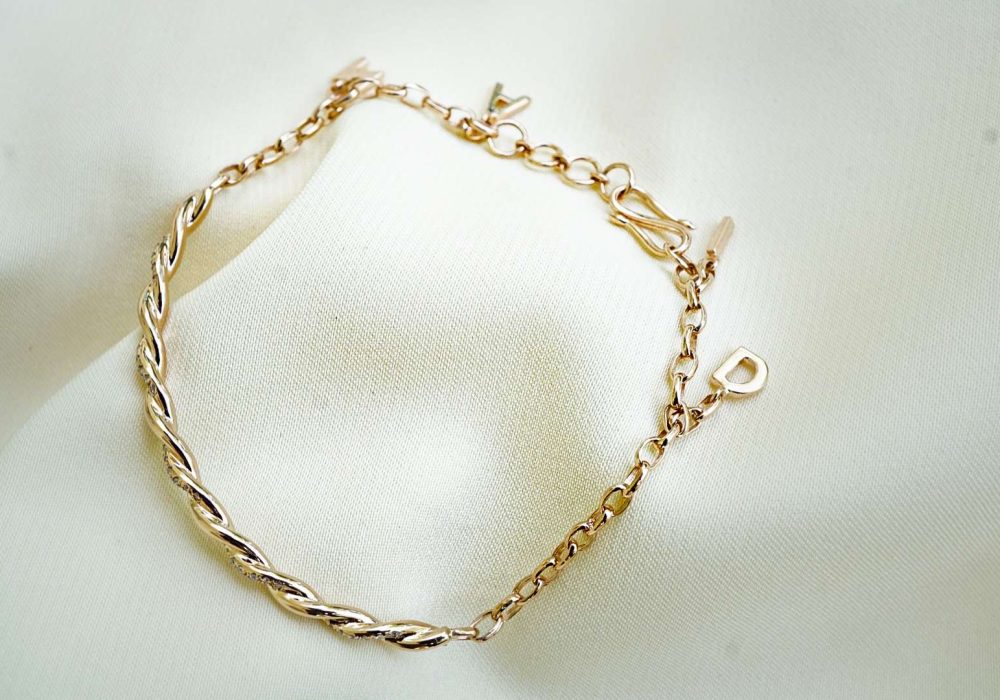
Gold Bracelet
A Glittering History of Gold Jewelry
The allure of gold jewelry dates back centuries, transcending cultures, civilizations, and eras. The ancient Egyptians believed that gold was the flesh of the gods, and it was often used to adorn pharaohs and other high-ranking individuals.
In ancient Rome, gold jewelry symbolized wealth and power, and it was worn as a status symbol by the elite. Throughout history, gold jewelry has been a universal symbol of opulence, beauty, and luxury, making it a coveted possession across the globe.
Splendor of Gold
Rose Gold: Romantic Allure
Rose gold, with its subtle pinkish tint, exudes a romantic and feminine charm. The infusion of copper into the gold alloy gives rise to its distinctive color. This metal has witnessed a resurgence in popularity, adorning various jewelry pieces, from delicate rings to intricate pendants.
Its warm undertones complement a wide range of skin tones, making it a beloved choice for modern jewelry enthusiasts. Its versatility makes it a favorite choice for both modern and classic designs. Rose gold infuses a piece of jewelry with a captivating blend of warmth and elegance.
Types of Gold Used in Jewelry
Gold comes in various purity levels, each denoted by a karat value. While 24K gold is the purest, it is also the softest and most malleable, making it less suitable for intricate designs. 18K and 14K gold strike a balance between purity and durability, offering a wide range of design possibilities. Additionally, rose gold, created by blending gold with copper, brings a romantic blush to jewelry.
The Intricate Designs of Gold Jewelry
Gold jewelry comes in an array of designs, from minimalist to ornate. Craftsmen often incorporate gemstones, intricate engravings, and filigree work to enhance the beauty of each piece. The diversity of designs ensures that there is something for every taste and occasion.
The Value of Gold in Jewelry & The Price of Gold
The value of gold in jewelry extends beyond its aesthetic appeal. Understanding gold prices today and the factors influencing them is crucial for both buyers and sellers. Market trends, geopolitical events, and economic conditions play a significant role in determining the price of gold.
Gold Price Today: Understanding Market Trends
The gold rate today is a reflection of the current market conditions. Investors and jewelry enthusiasts closely monitor gold prices as they fluctuate based on supply and demand dynamics. Factors such as economic stability, geopolitical tensions, and inflation can cause sudden shifts in gold prices.
Staying informed about the gold rate today empowers individuals to make informed decisions about buying or selling gold jewelry.
Factors Affecting Gold Prices
Several key factors influence the price of gold. Geopolitical events, such as conflicts and trade tensions, can drive investors to seek safe-haven assets like gold, leading to price increases. Economic indicators like interest rates and inflation rates also impact gold prices. Furthermore, shifts in the valuation of the U.S. dollar can impact the appeal of gold as an investment.
Gold Price vs. Gold Value
It’s important to distinguish between the price of gold and its intrinsic value. While the gold price fluctuates in response to market conditions, the intrinsic value of gold remains relatively stable over time.
This intrinsic value is rooted in gold’s rarity, durability, and historical significance. Understanding this distinction can help individuals make informed decisions about the purchase and sale of gold jewelry.
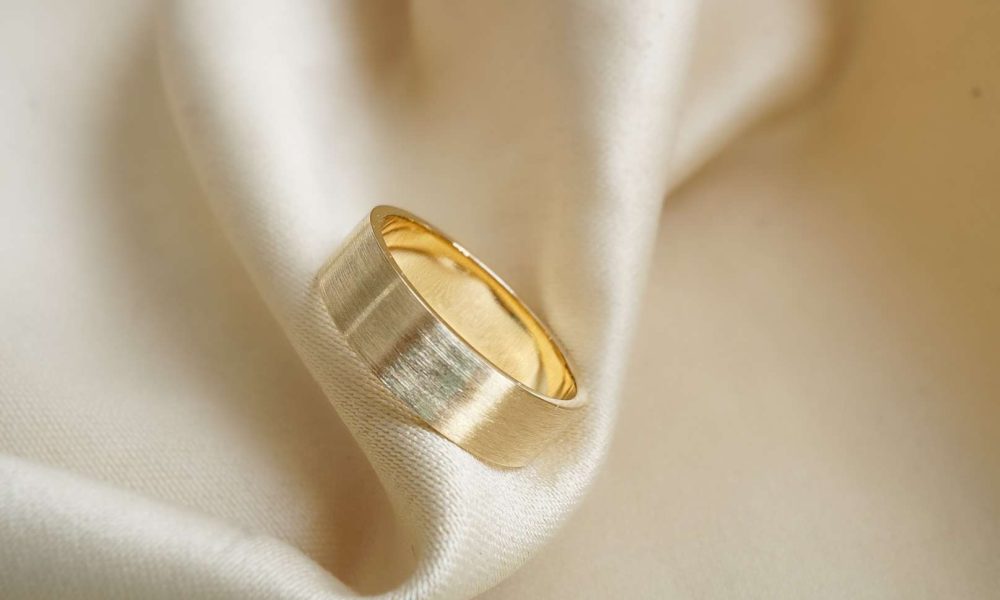
Gold Ring
Owning a Piece of Luxury: Investing in Gold Jewelry
Investing in gold jewelry offers not only a beautiful accessory but also a potential store of value. Gold’s enduring worth has made it a sought-after investment for centuries. Understanding the gold price per ounce and the benefits of owning physical gold can guide your investment decisions.
Buy Gold
Purchasing gold is more than a transaction; it’s a way to safeguard value and financial security. Gold’s history as a safe haven makes it an essential asset for diversifying investments and hedging against economic uncertainty. Whether in the form of coins, bars, or jewelry, owning gold offers a tangible connection to prosperity and a shield against inflation and market volatility.
Gold Price Per Ounce: Assessing the Investment
The gold price per ounce serves as a reference point for investors and collectors. Monitoring this price allows individuals to evaluate the value of their gold jewelry and make decisions about buying or selling. Additionally, the gold price per ounce is a crucial consideration for those interested in purchasing gold as an investment, as it directly affects the potential return on investment.
Benefits of Buying Gold Jewelry
Investing in gold jewelry offers several advantages. Not only does it provide a tangible asset with intrinsic value, but it also allows individuals to enjoy the beauty of their investment on a daily basis. Unlike other forms of investment, gold jewelry is a portable and personal asset that can be passed down through generations, carrying with it the stories and sentiments of the past.
Gold Coin
A gold coin is a piece of history, wealth, and artistry merged into a single exquisite item. These meticulously crafted treasures symbolize value across cultures and time periods. Each coin not only showcases coinage mastery but also holds economic, political, and cultural narratives.
From ancient civilizations to modern minting, gold coins remain sought-after investments and collector’s gems, embodying the enduring value of precious metals.
Gold Spot Price
The gold spot price reflects the immediate market value of gold. It’s the current price for buying or selling gold in real-time, capturing changes in supply and demand. Investors, traders, and institutions closely watch this price as a crucial reference point for decisions in the precious metals market.
It’s a foundational benchmark for transactions like futures contracts, options, and physical gold purchases. Fluctuations are influenced by factors such as economic indicators, geopolitics, and investor sentiment.
Staying informed about the gold spot price is vital for understanding its value, whether for investment or as a hedge against economic uncertainties.
Diverse Range of Gold Jewelry Designs
Gold Earrings: Enhancing Elegance
Gold earrings, especially gold earrings for women, are an indispensable cornerstone in the realm of jewelry. These pieces serve as not only adornments but also statements of style and individuality. From delicate gold stud earrings to elaborate chandelier designs, the options within the gold earrings design spectrum are as diverse as the occasions they complement.
Whether you seek to evoke sophistication with understated gold studs for a professional ensemble or to radiate opulence with intricately designed chandelier earrings at a glamorous evening affair, gold earrings wield the transformative power to enhance an individual’s overall appearance and confidence.
Gold Necklaces: Elevating Style with Enduring Sophistication
Gold necklaces, especially gold necklace for women, stand as timeless accessories that possess the remarkable ability to transform and elevate any ensemble. Rooted in history and steeped in elegance, these pieces are not merely adornments; they are expressions of personal style and statements of refined taste.
The world of gold necklace design encompasses an array of options, ranging from the classic gold chain to pendant necklaces and intricate chokers. This diversity ensures that there’s a piece to match every individual’s preferences, contributing to the unique tapestry of their style journey.
Gold Rings: Emblems of Love, Commitment, and Self-Expression
Gold rings, including gold ring for women and gold ring for men, occupy a cherished realm within the jewelry landscape, serving as profound symbols of affection, loyalty, and individuality. These iconic pieces not only encircle fingers but also encapsulate sentiments, representing love stories, life journeys, and personal milestones.
The spectrum of gold ring design caters to diverse preferences, embracing both minimalism and extravagance. From the unassuming elegance of sleek bands to the intricate exuberance of cocktail rings, these designs transcend gender boundaries, resonating with both men and women.
Whether adorning fingers as daily companions or making bold statements on special occasions, gold rings are more than jewelry; they are embodiments of self-expression, silently narrating tales of style and emotion with every glint and sparkle.
Gold Bracelets: Versatile Statements of Style for Men and Women
Bracelets, including gold bracelet for men and gold bracelet for women, stand as versatile accessories that infuse a touch of flair into any ensemble. Embracing both genders, gold bracelets offer an array of styles that cater to diverse preferences. For men, chunky link chains exude a robust charisma, while delicate bangles offer a subtle elegance.
Women, too, have a spectrum of choices, from intricately designed cuffs to dainty chains that grace the wrist with sophistication. Whether worn individually for a touch of understated charm or layered to craft a daring fashion statement, gold bracelets are not just ornaments; they’re embodiments of personal style that effortlessly fuse with any outfit, adding a dash of allure to the wearer’s persona.

Gold Diamond Ring
Gold Chains: Symbolic Elegance for Men and Women
Gold chains, spanning gold chain for men and gold chain for women, carry a profound cultural significance that resonates through time. Emblematic of strength and masculinity, men’s gold chains traverse a spectrum from bold and rugged to intricately patterned designs, enabling a personalized expression of style.
Meanwhile, women’s gold chains gracefully adorn necklines with a delicate touch, offering a perfect complement to any ensemble. These versatile pieces, including the alluring gold chain necklace, transcend gender boundaries, becoming vessels of elegance and personal identity.
Gold Pendants: An Intimate Expression of Identity and Affection
Gold pendants, be it a single gold pendant or an array of gold pendants, embody a distinctive avenue for showcasing individuality and cherished sentiments. These ornamental tokens transcend mere adornment, serving as personalized emblems that convey deep meaning.
Whether featuring a religious symbol, a birthstone pendant commemorating one’s birth month, or a custom-crafted design that encapsulates a unique story, pendants impart an intimate touch to any jewelry collection.
Worn close to the heart, these treasures forge an unbreakable connection between the wearer and the sentiment they represent, making gold pendants not just accessories, but cherished companions in life’s journey.
Gold Bangles: A Glorious Adornment for the Wrist
In the symphony of gold jewelry designs, gold bangles emerge as a captivating melody for the wrist. These circular wonders encircle the forearm with grace and allure, offering a striking balance between simplicity and opulence.
Gold bangles come in an array of widths and designs, ranging from slender, delicate bands to broader, ornate pieces adorned with intricate patterns and gemstone embellishments.
Their versatility extends across cultures and occasions – from stacking multiple slender bangles for a bohemian flair to adorning a single bold bangle as a statement piece for formal gatherings. Gold bangles are not merely accessories; they’re a rhythmic expression of style that add a touch of sophistication to every gesture.
Exquisite Gold Jewelry Designs for Women
Opulent Opal Rings: A Play of Colors
Opal rings are gaining popularity for their mesmerizing play of colors. When set in gold, opals exhibit a luxurious and captivating display that is both unique and enchanting. Opal rings are perfect for women who want to stand out with a touch of sophistication.
Gold Stud Earrings: Subtle Glamour
Gold stud earrings are a must-have for every woman’s jewelry box. These elegant and understated pieces can be worn daily and effortlessly transition from day to night. With various designs available, including gemstone studs and intricate patterns, gold stud earrings are a versatile accessory for any occasion.
Gold Choker Necklace: Adorning the Neckline with Elegance
A gold choker necklace exudes an enchanting charm, embracing the neck with a touch of sophistication. This close-fitting masterpiece effortlessly elevates any ensemble, whether it’s a classic LBD or a contemporary off-shoulder top.
With designs ranging from minimalist to intricate, a gold choker necklace is a versatile accessory that effortlessly transitions from day to night, making a bold statement no matter the occasion.
Rose Gold Necklace: A Whimsical Touch of Romance
The allure of rose gold is undeniable, casting a warm and romantic glow that complements various skin tones. A rose gold necklace infuses a whimsical touch into any look, radiating elegance and femininity.
From delicate chains adorned with heart pendants to intricate floral motifs, this blushing metal adds a subtle yet captivating dimension to jewelry collections, making every wearer feel like a modern-day enchantress.
Clover Necklace: A Symbol of Luck and Grace
A clover necklace, often embellished with precious gemstones, offers a unique blend of symbolism and beauty. The four-leaf clover, a universal emblem of luck, is rendered in gold to represent not only fortune but also grace. This intricate design can hold personal significance, making it a meaningful gift or a cherished accessory that accompanies its wearer on life’s journey.
Amethyst Ring: A Regal Touch of Glamour
Amethyst, a royal gemstone renowned for its enchanting purple hue, graces the world of gold jewelry with a regal touch. An amethyst ring becomes a focal point of elegance, capturing attention with its captivating color and the brilliance of gold.
Whether set in a solitaire design or surrounded by intricate diamond accents, an amethyst ring adds a touch of glamour and allure to any woman’s hand.
Gold Bracelet for Women: A Touch of Glamour on the Wrist
A gold bracelet for women is the embodiment of elegance and grace, adorning the wrist with a shimmering touch of glamour. From delicate chains that glisten with every movement to intricately crafted designs that tell tales of artistry, these bracelets elevate any ensemble with their timeless appeal.
Whether worn alone for a subtle statement or layered to create a striking visual effect, a gold bracelet for women is more than jewelry; it’s a celebration of femininity and individuality, captivating hearts with every glimpse.
Distinguished Gold Jewelry Designs for Men
Masculine Gold Chains: Bold and Assertive
Gold chains for men exude strength and confidence. Whether it’s a classic Figaro chain or a thicker Cuban link, these designs make a bold statement. Men’s gold chains can be worn alone or layered with other chains for a stylish and rugged look.
Striking Gold Rings: A Blend of Style and Strength
Gold rings for men encompass a range of designs that balance style and masculinity. From sleek signet rings to chunky statement pieces, these rings reflect individuality and charisma. Men can choose from a variety of designs that suit their preferences and lifestyle.
Mens Gold Bracelets: A Fusion of Elegance and Strength
Mens gold bracelets transcend conventional accessories, merging elegance with masculinity. Ranging from timeless link chains to contemporary leather and gold combinations, these bracelets encapsulate the essence of modern men’s style.
Whether worn solo or layered for a more dynamic effect, mens gold bracelets add a touch of refinement, allowing men to showcase their inner strength and individuality through their choice of jewelry.
Gold Bangle Bracelet: A Bold Statement of Masculinity
For men who seek to make a distinctive style statement, a gold bangle bracelet offers a confident touch. These robust accessories encircle the wrist with a strong and masculine flair. From chunky, minimalist designs that exude strength to more intricate patterns that showcase artistry, a gold bangle bracelet becomes an extension of personal expression.
It complements both casual and formal looks, infusing an air of distinction into any ensemble.
Men's Gold Earrings: A Glimpse of Unconventional Elegance
In the realm of mens gold earrings, a world of unconventional elegance awaits. From subtle gold studs that subtly highlight the ears to more daring designs that capture attention, mens gold earrings redefine traditional notions of jewelry.
These accessories offer a glimpse into the wearer’s personality, adding a hint of edginess or sophistication, depending on the design. Whether for a formal event or a casual outing, mens gold earrings contribute to an ensemble’s overall appeal, making a distinct statement while remaining true to the wearer’s style.
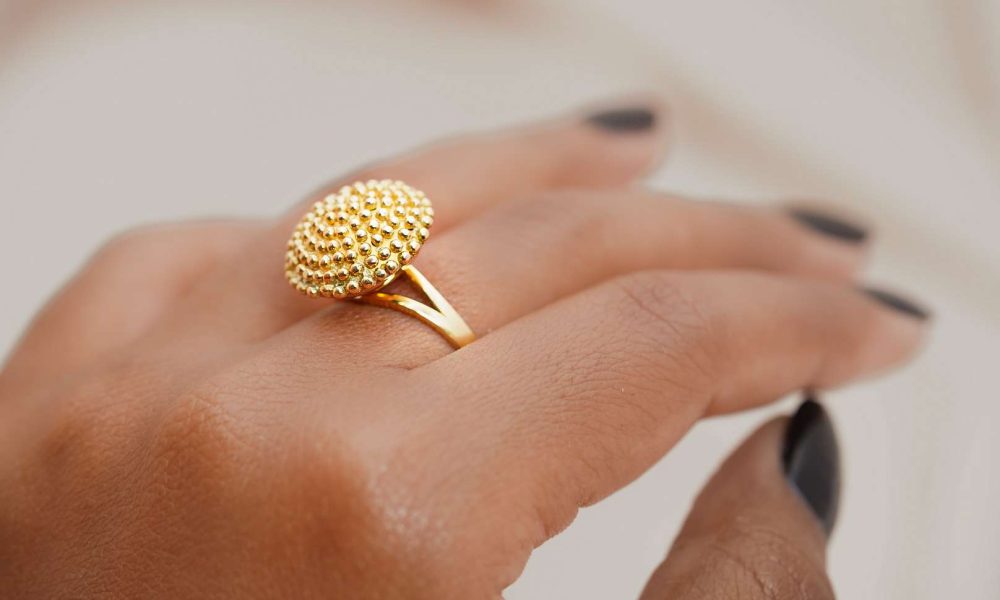
Gold Ring
Gold Filled Jewelry: Affordable Luxury with Lasting Charm
Amidst the world of gold jewelry, gold filled jewelry emerges as a brilliant alternative. Crafted by bonding a layer of real gold to a base metal, gold filled jewelry offers the allure of genuine gold at a more accessible price point.
These pieces exude lasting charm, as the gold layer is considerably thicker than that of gold-plated items, ensuring durability and longevity. From gold filled necklaces to bracelets and earrings, this option opens the door to exquisite designs that capture the essence of luxury without compromising on quality or style.
Final Thoughts
Gold jewelry has an enduring appeal that spans across generations and cultures. From the elegance of gold earrings that frame faces with delicate radiance to the sophistication of necklaces that gracefully adorn necklines, the versatility of gold jewelry designs ensures that there’s something for everyone.
Whether it’s a symbol of love, a statement of power, or an expression of individuality, gold jewelry continues to captivate and enchant. Its gleam has graced the regal necks of queens and the strong wrists of warriors, embodying both timeless elegance and formidable strength.
As trends come and go, the timeless allure of gold jewelry remains steadfast, making it an everlasting treasure in the world of fashion and style. Gold jewelry isn’t just an accessory; it’s a testament to the enduring human fascination with beauty, craftsmanship, and the emotional connections we forge with the pieces we wear.
It’s an enduring legacy that transcends time, culture, and trends, a precious thread that binds generations together through the shared love for these gleaming treasures.
FAQs About Gold Jewelry
Gold jewelry has held immense significance across cultures and eras. In various civilizations, it symbolized wealth, power, and even divinity. From ancient Egypt to Renaissance Europe, gold jewelry adorned monarchs and nobility, signifying status and opulence. Today, it remains a timeless emblem of elegance and personal style.
Choosing the right gold jewelry design depends on the occasion and your personal style. For formal events, intricate designs like chandelier earrings or statement necklaces can make a bold statement. Minimalist gold studs or delicate chains are perfect for everyday wear. Consider your outfit, the event's formality, and your comfort level when selecting the design.
Absolutely! Gold jewelry is versatile and transcends gender boundaries. While certain designs may lean towards masculine or feminine aesthetics, many pieces, such as gold rings, necklaces, and bracelets, are suitable for both men and women. The key is to choose designs that resonate with your personal style and preferences.
To keep your gold jewelry looking radiant, follow these tips: Store pieces separately to prevent scratching, avoid exposing them to harsh chemicals and abrasives, and remove them before swimming or using cleaning products. Periodically clean your gold jewelry with mild soap and warm water, gently scrubbing with a soft brush. A professional jeweler can also provide cleaning and maintenance services.
Absolutely. Personalizing gold jewelry adds sentimental value and uniqueness. Engraving names, dates, or special messages on rings, bracelets, or pendants can commemorate significant moments. Birthstones or gemstones with personal significance can also be incorporated into designs. Many jewelers offer customization options to help you create a piece that tells your story.
Solid gold jewelry is made entirely of the precious metal, often indicated by a karat mark (e.g., 14K or 18K). Gold-plated jewelry, on the other hand, consists of a base metal coated with a thin layer of gold. Solid gold is more valuable and durable, while gold-plated jewelry is more affordable but may wear off over time.
The purity of gold in jewelry is typically measured in karats (K). A higher karat indicates a higher gold content. For example, 24K gold is pure gold, while 18K gold is 75% gold and 25% alloy. Most jewelry is marked with its karatage to indicate purity.
Yes, caring for gold jewelry with gemstones requires extra attention. Avoid exposing it to harsh chemicals, extreme temperatures, and sudden impacts. Clean such jewelry gently with a soft brush and mild soapy water, and store it separately to prevent scratching.
While gold is relatively durable, it's advisable to remove your gold jewelry before engaging in activities like swimming in chlorinated pools or vigorous exercise. Chlorine can affect the metal's surface, and sweat can cause buildup that may dull the jewelry's shine.
Hallmarking on gold jewelry verifies its authenticity and purity. It often includes information about the manufacturer, karatage, and sometimes the location where it was tested and hallmarked. Checking for hallmarks ensures you're getting genuine gold of the quality indicated.

